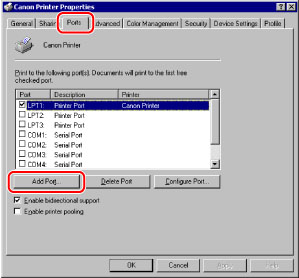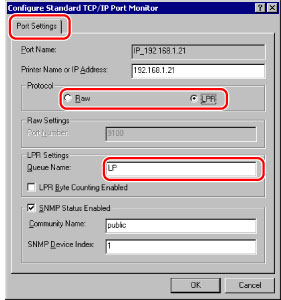In the following procedures, items displayed on the screens for Windows 2000 are used. The items displayed may differ according to your operating system.
|
NOTE
|
|
If you are using Windows Vista or later, a dialog box may be displayed while you are performing the procedure. In this case, enter a user name and password. For more information, see the manuals provided with the operating system.
|
1.
Install the driver.
Install the driver according to the following procedures indicated in the manual for each driver:
If you want to use the UFR II/PCL/PS printer driver
See the procedure for dynamic installation in the Printer Driver Installation Guide.
See the procedure for dynamic installation in the Printer Driver Installation Guide.
If you want to use the fax driver
See the procedure for dynamic installation in the Fax Driver Installation Guide.
See the procedure for dynamic installation in the Fax Driver Installation Guide.
|
NOTE
|
|
The print application will be LPD and the print queue will be set to <LP> if the driver has been installed according to the above procedures.
This machine enables you to specify print queues other than <LP>. You can also use Raw as the print application. For instructions on how to change the settings, see "Changing the Port after Installing the Driver."
|
1.
In the printer properties dialog box of the printer you installed, select the [Ports] sheet → click [Add Port].

2.
In the [Printer Ports] dialog box, from [Available ports types], select [Standard TCP/IP Port] → click [New Port].
3.
According to the instructions on the Add Standard TCP/IP Printer Port Wizard, in [Printer Name or IP Address], enter the printer IP address or printer host name → exit the Wizard.
If the dialog box displays <Additional Port Information Required>, follow the instructions on the screen to search again, or click [Standard] → click [Canon Network Printing Device with P9100] under [Device type].
4.
In the printer properties dialog box, click [Configure Port] → select [LPR] or [Raw].

If you use LPD, you can specify one of the following print queues in [Queue Name].
LP
The machine prints according to its spool settings. Normally, <LP> is entered as a print queue.
The machine prints according to its spool settings. Normally, <LP> is entered as a print queue.
SPOOL
The machine prints only after spooling a print job on the hard disk, regardless of its spool settings.
The machine prints only after spooling a print job on the hard disk, regardless of its spool settings.
DIRECT
The machine prints without spooling a print job on the hard disk, regardless of its spool settings.
The machine prints without spooling a print job on the hard disk, regardless of its spool settings.
1.
Install the driver.
Install the driver according to the instructions in the manual for each driver.
If you want to use the UFR II printer driver
See the Mac UFR II Driver Guide.
See the Mac UFR II Driver Guide.
If you want to use the PS printer driver
See the Mac PS Driver Guide.
See the Mac PS Driver Guide.
If you want to use a PS printer driver provided by Apple Inc.
For instructions on how to install the corresponding PPD file from Canon, see Chapter 14, "Before Printing from Computers," in Getting Started. For details about the PS printer driver, see the documentation provided with your Macintosh.
For instructions on how to install the corresponding PPD file from Canon, see Chapter 14, "Before Printing from Computers," in Getting Started. For details about the PS printer driver, see the documentation provided with your Macintosh.
|
IMPORTANT
|
|
The PS printer driver can be used only in a Mac OS X 10.4.9 or later environment.
If you are using the imagePASS, see the manual provided with the imagePASS.
If you are using the imagePASS, some functions are not available with this machine. For details, see the manual provided with the imagePASS.
|
The machine supports the LPD print application for printing over TCP/IP networks.
The following procedures are only examples. The setup procedures for your environment may differ.
|
IMPORTANT
|
|
If communication via the IP address is not permitted in [Firewall Settings] on the Network screen, you cannot specify the spooling system.
|
1.
Log in to a workstation as a superuser → set up the spooling system.
Add the following to the /etc/printcap file:
<Print queue name>|<comment>:\
:lp=<device special file>:\
:sd=<spool directory>:\
:rm=<printer IP address or host name>:
Start the admintool utility → click [Browse] → [Printers] → [Edit] → [Add] → [Access to Printer] → in [Printer Name], enter the desired print queue name → in [Print Server], enter the IP address or printer host name.
|
NOTE
|
|
The admintool utility is included with the operating system. For specific operating instructions, see the operating system manual.
You can specify one of the following print queues.
LP
The machine prints according to its spool settings. Normally, <LP> is entered as a print queue. SPOOL
The machine prints only after spooling a print job on the hard disk, regardless of its spool settings. DIRECT
The machine prints without spooling a print job on the hard disk, regardless of its spool settings. When the job log appears on the touch panel display of the machine, <unknown> may be displayed as the document name and user name of print data transmitted to the machine over a UNIX network. (To display the job log, press
 → [Copy/Print] → [Log] on the touch panel display.) → [Copy/Print] → [Log] on the touch panel display.) |